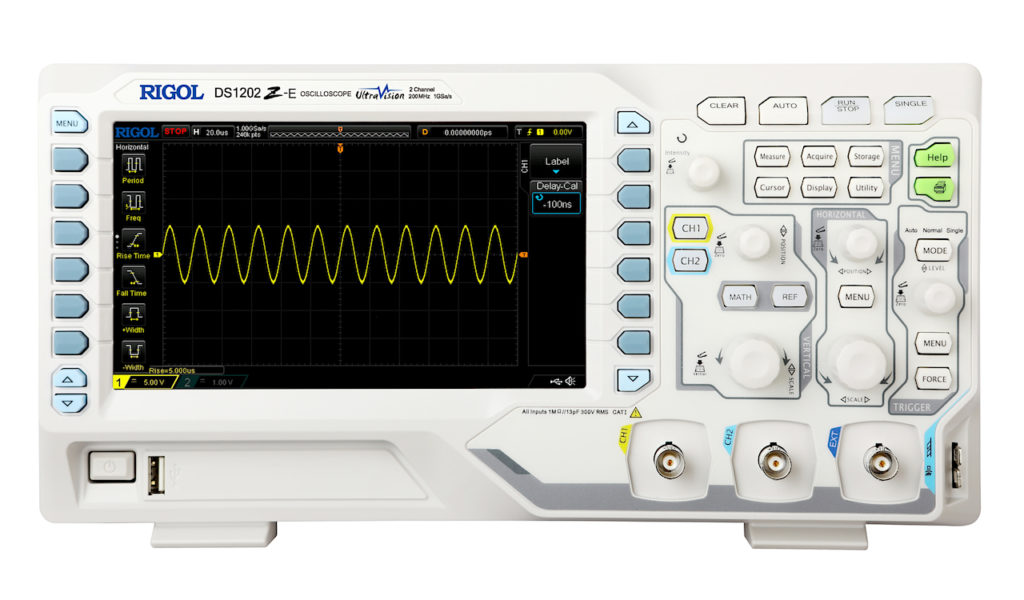Everyone has tools that are essential to their job. Some people need hammers and nails, others scalpels and tweezers, and yet others PowerPoint and Excel. Using the right tool determines how easy or difficult it is to accomplish the task at hand, the quality of the final result, or simply the success or failure.
One of the most indispensable tools for hardware and firmware engineers is the oscilloscope. It is the electronic engineering equivalent to an EKG monitor—but instead of plotting the patient’s heart rhythms, it shows engineers the signals in their electronic boards and devices. Also, like a high-speed camera, it can take a snapshot of a very short event and freeze it on screen so that it is possible to examine signals and waveforms lasting only few microseconds or even shorter.
Features and Parameters
Oscilloscopes come in many different configurations with variety of features, performance levels, and corresponding price points. Some of the main things to consider when selecting an oscilloscope include the analog bandwidth, rise time, number of channels (analog and digital), vertical resolution, memory depth, waveform update rate, and of course cost.
Bandwidth is most important parameter since it limits the frequency range of signals that the scope can process and represent. When working with digital signals, make sure to select a scope with bandwidth at least 5x higher than the maximum frequency. Memory depth is another major parameter: larger memory lets you capture a relatively long waveform that you can later zoom into to inspect short details. It is akin to having more megapixels in your digital camera.
For embedded systems projects that typically use I2C, SPI, and UART serial busses it is also important to have built-in serial protocol decoding and corresponding triggering options. This makes it considerably easier to make sense of the signals shown on the display as well as to trigger on the desired data transfer.
These parameters as well as many others are discussed in detail in a Tektronix article about evaluating oscilloscopes. It’s a good idea to go through the article and learn the importance of each parameter and feature. Note that many oscilloscopes today can be upgraded after purchase. Basically, the manufacturer produces only one (or few) models and sells them at different price points after limiting or disabling some of the features. You can buy a less expensive scope and later “upgrade” it to higher specs by purchasing a license key that unlocks more features—like higher bandwidth or serial protocol decoding. Of course, make sure to check what upgrade options are available before ordering.
The Rigol DS1202Z-E
While many engineers wish to have the latest state-of-the-art high-bandwidth, fully-feature-loaded scope on their bench, the reality is that these oscilloscopes can cost a fortune and are only justified when their performance levels are really need. However, for many projects a good-enough instrument is sufficient, especially considering small garage startups, hobby projects, education environments, or even deployment at manufacturing lines since in these scenarios cost is a very important factor.
One such oscilloscope is the Rigol DS1202Z-E: a 200-MHz bandwidth, 2-channel scope with great set of features and a very low price around $300. While definitely at the low-end of the spectrum, this little scope offers a nicely rounded set of features that, combined with its low price, make it a must-have for any small/home engineer’s desks.

Here are the basic specs:
- 200 MHz analog bandwidth
- 2 analog channels + external trigger input
- 24 Msamples memory depth
- 30000 waveforms/second capture rate
- Vertical scale from 500 µV/div to 10V/div
- I2C, SPI, and UART decoding and triggering
- 7-inch 800×480 TFT display
- USB and LAN ports
- Pass/fail output
- Affordable
The scope works pretty much as expected. Interacting with the buttons and knobs sometimes has small but noticeable delay—but once everything is set up, the scope works quite well and is well worth its price. The pass/fail output is useful in automated factory environments where the oscilloscope is part of manufacturing-line test station.
Rigol is a Chinese company headquartered in Suzhou, very close to Shanghai. It has been in the test and measurement business for many years and has an impressive lineup of instruments—all the way to 5-GHz bandwidth scopes. You can find out more at its US web site and Chinese web site.